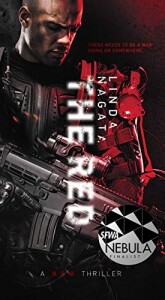 Having found some writers I enjoyed in Gardener Dozois’ The Year’s Best Science Fiction: Thirty-fifth Annual Collection from 2018, I’ve dutifully set about reading some long-form fiction by a few of them. First up is Linda Nagata, whose novel The Red, the first of a near-future military tech thriller trilogy.
Having found some writers I enjoyed in Gardener Dozois’ The Year’s Best Science Fiction: Thirty-fifth Annual Collection from 2018, I’ve dutifully set about reading some long-form fiction by a few of them. First up is Linda Nagata, whose novel The Red, the first of a near-future military tech thriller trilogy.
I think of myself as … not exactly a pacifist, but pacifist adjacent. It’s hard to square that with how much I enjoy good military SFF. My experience with it goes back to early Heinlein like Starship Troopers, through Niven-Pournelle and Joe Haldeman, and now you can add Linda Nagata to that list.
The Red is told through the eyes of Lt. James Shelley, a squadron leader in a near future U.S. Army when Eisenhower’s military-industrial complex has pretty much taken over the country. Or rather, the world. The international consortium of defense contractors (DCs) is powerful enough to get away with starting limited action conflicts anywhere on the globe, off of which they get ever richer. When we meet “Shelley” he and his understaffed crew are in an unnamed country in the African Sahel holding down the fort, doing nightly patrols, and trying not to get bored and complacent. They’re ostinsibly there to keep “insurgents” from coming over the border, but Shelley has a feeling something bigger is coming down.
In fact, Shelley is having a lot of feelings lately. He and his crew are what’s called an LCS or linked combat squad. They wear skullcaps that interact with their brains and link them to each other, to their “Guidance” handlers, and to all manner of online stuff like feeds from overhead drones. Their emotions and pain levels can also be manipulated by Guidance through them. Their bodies are augmented by removable AI-linked exoskeletons (which they call their Dead Sisters); other implants allow them to target and fire weapons with superhuman speed and accuracy. (In this, Shelley reminds me of Martha Wells’s Murderbot character, only fully human and somewhat more vulnerable. Also less funny.)
But lately, Shelley has been having premonitions of impending bad things, which have allowed him to (mostly) avoid being caught by surprise and losing squad members. When he mysteriously knows in advance about a surprise attack during a battle, he’s not the only one who notices and wonders about this new superpower. He and his superiors (and others!) start to wonder if it’s a sentient AI, interfering in politics and war for its own ends … whatever those may be. The mystery further deepens when he finds out that his and his unit’s story is being turned into a viral reality video series.
The story is told in first person, present tense, so we only see and hear and know what Shelley sees and hears and knows. As it’s happening. It’s a most effective way to tell this kind of story. Nagata is equally adept at portraying the adrenaline and confusion of battle as she is at the claustrophobia and confusion of undergoing physical and psychological trauma.
The Red: First Light is an absolute page-turner, so it’s on to the next installment for me!
(Saga Press, 2015)
